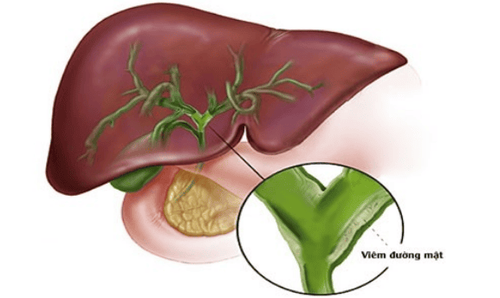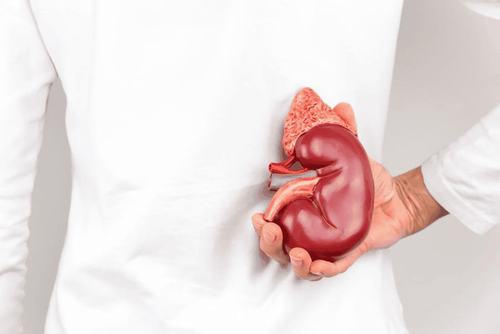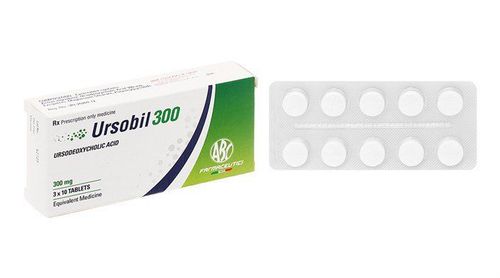This is an automatically translated article.
Ursofast is often prescribed for the treatment of primary biliary cirrhosis, hepatobiliary disorders due to cystic fibrosis in children or cholesterol-rich gallstones,... To use Ursofast safely, limit the side effects. side effects and soon bring effective treatment, patients need to strictly follow the treatment regimen suggested by the doctor before.
1. What is Ursofast?
Ursofast belongs to the group of gastrointestinal drugs, used for cases of primary biliary cirrhosis, gallstones or some other hepatobiliary disorders in both children and adults. Ursofast is manufactured by Hera Biopharmaceutical Co., Ltd - Vietnam in the form of film-coated tablets, each box includes 3 blisters x 10 tablets. The main active ingredient of Ursofast is Ursodeoxycholic acid (micronized form) 300 mg. Besides, in each pill there are also other auxiliary excipients.2. What does Ursofast do?
2.1. Uses of active ingredient Ursodeoxycholic acid Ursodeoxycholic acid is known as a natural bile salt and is present in the body in very small amounts. Unlike other endogenous bile salts, Ursodeoxycholic acid has very hydrophilic properties but does not carry a detergent effect.
According to research, Ursodeoxycholic acid in Ursofast affects the liver-intestinal cycle of endogenous bile acids. This enhances bile secretion, while decreasing bile reabsorption by inhibiting active intestinal reabsorption, thereby reducing endogenous bile acid levels in the blood.
Currently, Ursodeoxycholic acid is evaluated as an effective treatment for gallstones through its effect on reducing cholesterol levels in bile. This effect comes from a combination of different mechanisms, including cholesterol reabsorption and increased hepatic conversion of cholesterol to bile acids by increasing the activity of the liver enzyme cholesterol 7 alpha-hydroxylase. On the other hand, Ursodeoxycholic acid also helps to maintain cholesterol in bile in a soluble form.
2.2. Indications and contraindications to using Ursofast drug Ursofast drug is used according to the doctor's prescription to effectively and quickly treat the following problems:
Treatment of chronic hepatobiliary disease, typically primary biliary cirrhosis. , liver disease caused by viscous mucus or sclerosing cholangitis. Treatment of small-medium cholesterol gallstones (less than 15mm in diameter), asymptomatic, unenhanced and with a normal functioning gallbladder (determined by X-ray of the gallbladder). Treatment of patients who have stones but cannot perform surgery. Treatment of hepatobiliary disorders associated with cystic fibrosis in children aged 6 to under 18 years. However, Ursofast should not be used in the following patients without a doctor's prescription:
People with a history of hypersensitivity or allergy to Ursodeoxycholic acid or any of the excipients contained in this medicine. medicine. The patient has a calcified contrast stone. People with acute cholecystitis/bile duct inflammation. People with bile duct obstruction, including obstruction of the common bile duct and cystic duct. The patient has frequent biliary colic. People with reduced ability to contract the gallbladder. People with chronic liver disease, small bowel inflammation, colitis or peptic ulcer. Pregnant women, planning to become pregnant or nursing mothers.
3. Dosage and how to use Ursofast
Depending on the medical condition, the doctor will prescribe different doses of Ursofast, specifically:
Treatment of primary biliary cirrhosis: Use a dose of 10-15mg / kg body weight / day, divided into 2 – 4 times/day. Treatment of cholelithiasis rich in cholesterol: Use a dose of 5-10mg/kg body weight/day. The recommended dose of Ursofast is 7.5mg/kg body weight/day for patients of average health. For obese patients, a dose of 10mg/kg body weight/day can be used, 2 to 3 tablets/day depending on body weight can be used. The usual duration of treatment for cholesterol gallstones is 6 months. If the stone is more than 1cm in size, the patient needs to be treated for about 1 year. Treatment of chronic hepatobiliary disease: Ursofast dose is 13-15mg/kg body weight/day. Patients can start with a dose of 200mg. day, then gradually increase the dose to reach the optimal therapeutic dose in about 4-8 weeks. Treatment of acquired hepatobiliary disease associated with viscous mucus disease: Use the optimal dose of 20mg/kg body weight/day. Treatment of hepatobiliary disorders related to cystic fibrosis in children: 20mg/kg body weight/day, 2-3 times a day. In case of necessity, the dose for children can be increased to 30mg/kg body weight/day. How to use Ursofast safely and effectively:
Ursofast is made in the form of film-coated tablets, so the drug will be taken orally with filtered water. The time and frequency of taking Ursofast will be specified by a gastroenterologist. As a general recommendation, Ursofast is usually recommended once in the evening, or patients can divide it into 2 doses in the morning and evening. Patients should pay attention to follow all instructions on the dose of Ursofast recommended by the doctor. Avoid calculating, adjusting the dose or changing the time of taking the drug on your own.
4. What side effects can Ursofast cause?
During the treatment of hepatobiliary disorders with Ursofast, patients are at risk of experiencing some of the following side effects:
Digestive disorders such as diarrhea, loose stools, severe right upper abdominal pain ( very rare), nausea or vomiting. Rare hepatobiliary disorders, such as formation of calcified and undissolved bile acids (risk of surgery), development of decompensated cirrhosis with treatment of advanced primary biliary cirrhosis. Certain disorders of the skin or subcutaneous tissue such as itching, rash or hives. When any of the above mentioned symptoms appear while taking Ursofast, the patient should stop treatment and notify the doctor as soon as possible. Early detection and diagnosis of problems related to Ursofast will help doctors provide effective treatment for patients, thereby preventing other health risks.
5. Notes when using Ursofast
Here are some recommendations that patients need to pay special attention to to make Ursofast treatment safe and effective soon:
Ursofast should be taken under the control of a medical person. . Liver function parameters such as -GT, ALT or AST should be monitored every 4 weeks during the first 3 months of treatment with Ursofast, then every 3 months thereafter. once. In cases where the gallbladder cannot be visualized on radiographs or in the presence of calcified gallstones, impaired contractility of the gallbladder, or in patients with frequent biliary colic, the use of the drug should be avoided. Ursodeoxycholic acid. If diarrhea occurs, the patient should reduce the dose of Ursofast, however, if diarrhea persists, treatment should be discontinued. Rectal monitoring should be performed when patients are on long-term use of Ursodeoxycholic acid. For cases of cholestasis leading to rash, patients need to gradually increase the dose of Ursofast to 200mg/day. In addition, patients should also use Cholestyramine at the same time, but need to use Ursodeoxycholic acid about 5 hours. Several animal studies have reported that Ursodeoxycholic acid has a teratogenic potential. Ideally, do not use Ursofast for women who are pregnant, unless directed by a doctor. Always check the expiry date of Ursofast before using it to avoid taking the expired medicine. Check the quality of the tablet, discard immediately if there is any sign of mold, deformation, discoloration or watery discharge.
6. Drug interactions
Avoid co-administration of Ursofast with the following other medicines:
Estrogens, when taken together with Ursodeoxycholic acid, may increase bile cholesterol. Other bile acid-binding drugs, such as activated charcoal or antacids. Concomitant use of these drugs with Ursodeoxycholic acid may reduce the therapeutic effect of Ursofast. The basic information about Ursofast in the above article is for reference only. Because this is a prescription drug, patients should not use it on their own, but need to contact a specialist directly to get an appropriate prescription to ensure safety for health.













